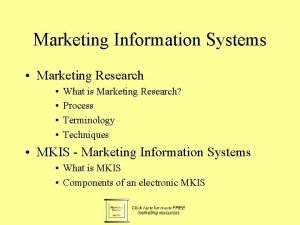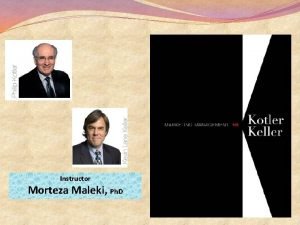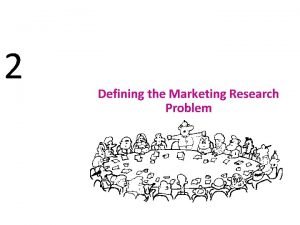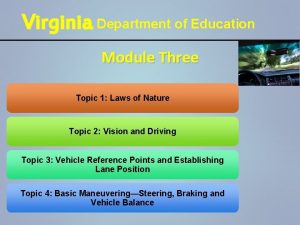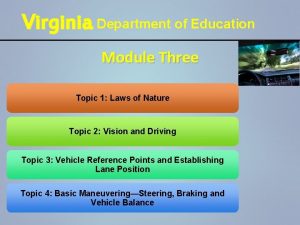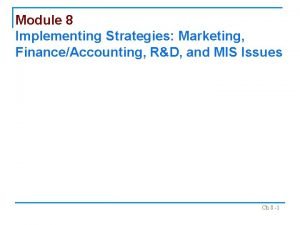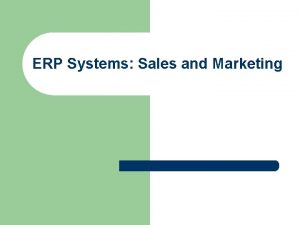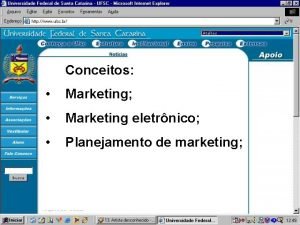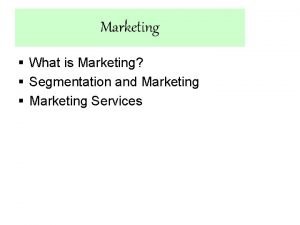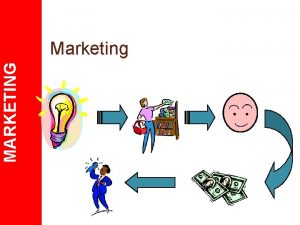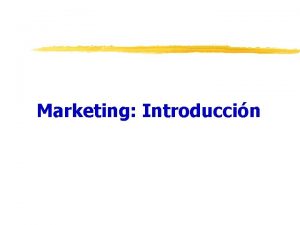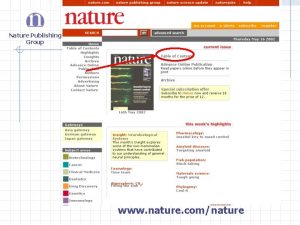Marketing Research N 6 Module 1 The nature










































- Slides: 42

Marketing Research N 6

Module 1: The nature and scope of marketing research MISSION AND AIMS OF A MARKETING RESEARCH ENTERPRISE The mission and goals of any organization must be clearly formulated. The organisation should have insight into what they want to achieve. This will enable the management team to make decisions based on the mission and goals of the organisation. A mission statement is a written declaration of the organisation, which expresses the will and objective of that organisation. www. futuremanagers. com

Module 1: The nature and scope of marketing research (continued) MARKETING RESEARCH AND DECISION MAKING Marketing managers make numerous strategic and tactical decisions in the process of identifying and satisfying customer needs. Decision makers in marketing make decisions about potential opportunities, target markets, market segmentation and the implementation of marketing programmes. This process is complicated by controllable variables such as product, price, promotion and place. www. futuremanagers. com

Module 1: The nature and scope of marketing research (continued) DEFINITION OF MARKETING RESEARCH Marketing research is the systematic and objective identification, collection, analysis and dissemination of information for assisting management in decision making related to the identification and solution of problems and opportunities in marketing. www. futuremanagers. com

Module 1: The nature and scope of marketing research (continued) APPLICATION OF MARKETING RESEARCH IN DIFFERENT AREAS The application of marketing research can be through: Problem identification or Problem solving research is opportunities are undertaken to arrive at a solution. help identify problems which may The findings of problem solving not be visible on the surface but research are used in making are there and will most likely arise decisions, which will solve specific in the future. marketing problems. www. futuremanagers. com

Module 1: The nature and scope of marketing research (continued) THE ROLE OF MARKETING RESEARCH IN THE MARKETING CONCEPT The role of marketing research is: • To conduct studies to determine what consumers want before any decisions regarding marketing strategies are taken. • To supply the marketing manager with the necessary information. • To determine how the client’s needs can be ultimately satisfied. • To analyse the collected information and find previously unnoticed opportunities or problem areas. www. futuremanagers. com

Module 1: The nature and scope of marketing research (continued) THE RELATIONSHIP BETWEEN MARKETING RESEARCH AND THE PRODUCT LIFE CYCLE In each phase of the product lifecycle, there are opportunities and problems. The different phases include: • Introduction phase; • Growth phase; • Matured phase; and • Declining phase. www. futuremanagers. com

Module 1: The nature and scope of marketing research (continued) THE RELATIONSHIP BETWEEN MARKETING RESEARCH AND MIS/DSS Marketing Information System (MIS) is a formalised set of procedures that is always generating, analysing, storing and distributing information to marketing decision makers. Decision Support System (DSS) is an integrated system that includes hardware, communication networks and database software. The system continuously collects and interprets information for decision makers. www. futuremanagers. com

Module 1: The nature and scope of marketing research (continued) THE FUNCTION OF MARKETING RESEARCH IN A BUSINESS Marketing research can be conducted inside the business, if it has its own research department or an outside firm can also be appointed to perform this function for the firm. www. futuremanagers. com

Module 1: The nature and scope of marketing research (continued) ADVANTAGES AND DISADVANTAGES OF MARKETING RESEARCH Advantages Disadvantages Guides managers towards the correct decision. Bias - the research project might be influenced by the researcher’s philosophy. It removes uncertainty by providing correct information about the marketing research environment. It identifies possible problems or opportunities. Time frame – it might take a long time for managers to get the results of a research project. It enhances effective decision-making. Exact science – marketing research is not an exact science. It contributes to the formulation of appropriate policies. www. futuremanagers. com

Module 1: The nature and scope of marketing research (continued) WHEN SHOULD A FIRM UNDERTAKE A MARKETING RESEARCH PROJECT? • When information on the topic is not available. • To formulate effective marketing policies. • When there is a problem with the marketing programme. • When decision makers have to evaluate two options. • To collect information about the best strategy for a product’s lifecycle. • When management would like to know why a programme was effective. www. futuremanagers. com

Module 2: The marketing research process STEPS IN THE RESEARCH PROCESS Step 1: Define the marketing research problem. Step 2: Preliminary investigation. Step 3: Hypothesis development. Step 4: Expansion of the information schedule. Step 5: Identify and choose sources of data. Step 6: Data collection and sample design. Step 7: Data preparation and analysis. Step 8: Report. www. futuremanagers. com

Module 2: The marketing research process (continued) RESEARCH DESIGN A research design is a framework or blueprint for conducting the marketing research project. It details the procedures necessary for obtaining the information needed to structure or solve the marketing research problem. A good research design will ensure that the marketing research project is conducted effectively and efficiently. www. futuremanagers. com

Module 3: Source of information SECONDARY DATA Secondary data refers to information which is already available. It is found in internal sources such as sales invoices, previous marketing research records, annual reports, letters of complaint, credit reports, and stock sheets. External sources include guides, directories, indexes, statistical data, census, and publications. www. futuremanagers. com

Module 3: Source of information (continued) PRIMARY DATA Primary data refers to information which is originated by the researcher for the specific purpose of addressing the problem at hand. Primary data are applicable to two types of research: qualitative and quantitative research. www. futuremanagers. com

Module 3: Source of information (continued) POTENTIAL SOURCES OF ERROR IN RESEARCH DESIGNS www. futuremanagers. com

Module 4: The questionnaire design OBJECTIVES/FUNCTIONS OF A QUESTIONNAIRE A questionnaire is a formalised set of questions for obtaining information from respondents. A questionnaire must translate the information needed into a set of specific questions that the respondents will answer. It must inspire, motivate and encourage the respondent to become involved in the interview, cooperate with the interviewer and complete the interview. It must also minimise response error. www. futuremanagers. com

Module 4: The questionnaire design (continued) STEPS IN DESIGNING A QUESTIONNAIRE Step 1 – Determine the information needed. Step 2 – Determine the method of data collection. Step 3 – Determine the content of the individual questions. Step 4 – Determine the types of questions that will be used. Step 5 – Decide on the wording of the questions. Step 6 – Determine the order in which questions must be asked. Step 7 – Decide on the layout and reproduction of the questionnaire. Step 8 – Pre-test the questionnaire. www. futuremanagers. com

Module 4: The questionnaire design (continued) GUIDELINES TO INCREASE RESPONDENTS’ CO-OPERATION IN ANSWERING A QUESTIONNAIRE • Put sensitive topics at the end of the questionnaire. • Questions which refer to general behaviour or is common knowledge can be prefaced with a statement. • Ask the question in the third person. • Hide the difficult or embarrassing questions in a group. Go through the entire list of questions quickly. www. futuremanagers. com

Module 4: The questionnaire design (continued) GENERAL HINTS WHEN DESIGNING A QUESTIONNAIRE • Indicate the different questions contained in the questionnaire. • The formulation of these questions depend on the instructions of a test paper, assignment or examination. • Mention the name of the organisation conducting the research, the address, and introduction explaining the questionnaire. • Conclude the questionnaire with a statement thanking the respondent. www. futuremanagers. com

Module 4: The questionnaire design (continued) FIELDWORK Researchers have two important options when collecting data: • They can organise the fieldwork themselves or • They can contract with a fieldwork agency. It is important that the researcher plan the fieldwork constructively. www. futuremanagers. com

Module 5: The sampling process CONCEPTS DEFINITION Sampling is one of the components of the research design. The following concepts are important in order to understand sampling: Population: The aggregate of elements that share common characteristics. Element: The object about which or from which the information is desired. Census: Involves a complete analysis of the elements of a population. Sample: A sub-group of the population selected for participation in the study. www. futuremanagers. com

Module 5: The sampling process (continued) CLASSIFICATION OF SAMPLING METHODS Sampling methods are classified as non-probability sampling and probability sampling. • Non-probability sampling relies on the personal judgement of the researcher rather than chance in the selection of sample elements. • Probability sampling techniques vary in terms of sampling efficiency. Sampling efficiency is a concept, which reflects a trade-off between sampling cost and precision. www. futuremanagers. com

Module 5: The sampling process (continued) A SAMPLE VERSUS A CENSUS Different circumstances will determine whether a sample or a census must be used. However, in most cases a sample is usually better to use because: • A census has large budget. • Sampling errors. • Time available. • Attention to individual cases. • Size of population. • Secrecy. www. futuremanagers. com

Module 5: The sampling process (continued) ADVANTAGES AND DISADVANTAGES OF A SAMPLE Method Advantages Disadvantages Convenience Least expensive, least time consuming, most convenient. Selection bias. Sample not representative Not recommended for descriptive or casual research. Judgemental Low cost, convenient, not time consuming. Does not allow generalisation, subjective. Quota Sample can be controlled for certain characteristics. Selection bias, no assurance of representation. Snowball Can estimate rare characteristics. Time consuming. Simple random Easily understood. Results projectable. Difficult to construct sampling frame. Expensive. Lower precision. No assurance of representation. www. futuremanagers. com

Module 5: The sampling process (continued) ADVANTAGES AND DISADVANTAGES OF A SAMPLE (CONT. ) Method Advantages Disadvantages Systematic Can increase representation, easier to implement with simple random sampling, sampling frame not necessary. Can decrease representation. Stratified Includes all important sub-populations. Very precise. Difficult to select relevant stratification variables. Not feasible to stratify on many Variables. Expensive. Cluster Easy to implement. Cost effective. Imprecise. Difficult to compute and interpret results. www. futuremanagers. com

Module 5: The sampling process (continued) STEPS IN SAMPLING DESIGN Step 1 – Define the population. Step 2 – Determine the sampling frame. Step 3 – Select a sampling method. Step 4 – Determine the sample size. www. futuremanagers. com

Module 5: The sampling process (continued) PRINCIPLES FOR SELECTING A SAMPLE IN MARKETING RESEARCH • The sample must relate to the problem definition. • It must also be representative for whom the study is conducted. • A sample tested under conditions must produce the same results. • The sample value must be accurate. • Sampling errors must be limited as far as possible. • The sampling frame must be applicable to the target population. • The sampling size must reflect a proper ratio in relation to the population. www. futuremanagers. com

Module 6: Analysis of data DATA PREPARATION Data preparation should begin as soon as the first batch of questionnaires is received from the field or while the fieldwork is still in progress. Problems that are detected at this stage can be addressed and the fieldwork modified to incorporate any adjustments. www. futuremanagers. com

Module 6: Analysis of data (continued) DATA ANALYSIS Data analysis happens after data preparation has been done. Tabulation is a process of analysing data preparation and putting the data into different categories according to the variables. Two different tabulation methods include: • Single tabulation and • Cross tabulation. www. futuremanagers. com

Module 6: Analysis of data (continued) CONFIDENCE INTERVALS The confidence interval is the range into which the true population parameter will fall assuming a given level of confidence. The confidence interval in data processing specifies the level of precision. This is the maximum permissible difference between the sample mean and the population mean. It specifies the level of confidence and determines the standard deviation of the population. www. futuremanagers. com

Module 6: Analysis of data (continued) MEASURES OF VARIABILITY Range: Measures the spread of the data. Variance: The mean squared deviation from the mean. Standard deviation: The square root of the variance. www. futuremanagers. com

Module 6: Analysis of data (continued) BASIC MEASUREMENT SCALES Measurement means assigning numbers or other symbols to characteristics of objects according to certain pre-specified rules. In marketing research, not the consumers, but their perceptions, attitudes, preferences or other relevant characteristics are measured. Scales of measurement include: • Nominal scale; • Interval scale; and • Ordinal scale; • Ratio scale. www. futuremanagers. com

Module 6: Analysis of data (continued) CRITERIA FOR A GOOD MEASURING SCALE The findings of your results in a survey depend on how well it was measured. The instrument that you use should have the following characteristics: • Reliability; • Validity; and • Generalisability. www. futuremanagers. com

Module 6: Analysis of data (continued) OBJECTIVES FOR A GOOD MEASURING SCALE • Reliability; • Validity; • Sensitivity; • Relevance; • Versatile; and • Ease of response from respondents, www. futuremanagers. com

Module 7: Requisition analysis and forecasting REQUISITION ANALYSIS OR DEMAND ANALYSIS Because demand for services and products vary, businesses must have a thorough knowledge of the market. Information about the market can be obtained through: • Sales analysis; • Marketing segmentation; • Marketing potential; www. futuremanagers. com • By looking at the effect of change in the marketing mix; and • By observing your competitors.

Module 7: Requisition analysis and forecasting (continued) FORECASTING Market forecasting are the methods and techniques management uses to collect information to assess the markets’ probable development. Distinguish between three levels of forecasting: General economic forecasting; Industrial forecasting; and Company forecasting. www. futuremanagers. com

Module 7: Requisition analysis and forecasting (continued) THE CHOICE FOR A FORECASTING METHOD The choice of a method depends on: • The time span (long term or short term). • The frequency of use (how often do you need to make a forecast). • The type of product. • The data available. • The accuracy required. • The stability of the market environment. www. futuremanagers. com

Module 8: Reporting ROLE OF THE REPORT IN MARKETING RESEARCH The report is the tangible product of the research effort. The report serves as a historical record of the marketing research project. Management decisions are guided by the report. Management’s decisions to do marketing research in the future or to use the particular research suppliers again, will be influenced by the perceived usefulness of the report and its presentation. www. futuremanagers. com

Module 8: Reporting (continued) GUIDELINES FOR WRITING A REPORT A report should be written for a specific reader or readers. The report must be logically structured and clearly written. The report must be reproduced professionally – edited and proofread, printed on quality paper and properly bound. Objectivity should guide the report writing. It is important to reinforce key information in the text with tables, graphs, pictures and other visual devices. www. futuremanagers. com

Module 8: Reporting (continued) THE REPORT FORMAT There are different formats in which research reports can be prepared, but most include: • The title page; • Letter of transmittal; summary; • Introduction; • Letter of authorisation; • The methodology; • Table of contents; • Management www. futuremanagers. com • Interpretation and conclusions; • Limitations and shortcomings; and • Conclusions and recommendations.

Module 8: Reporting (continued) TYPES OF REPORTS The following types of reports can be used to express ideas in writing: • Progress report. • Basic report. • Publications. • Technical reports. • Management reports. www. futuremanagers. com
 Principles of marketing module 2 answer key
Principles of marketing module 2 answer key Marketing research nature
Marketing research nature The nature of marketing research
The nature of marketing research Practical research nature of inquiry and research
Practical research nature of inquiry and research Finer segmentation strategy
Finer segmentation strategy Marketing information systems and marketing research
Marketing information systems and marketing research Define marketing information management
Define marketing information management Marketing information systems and marketing research
Marketing information systems and marketing research Marketing information system kotler
Marketing information system kotler Marketing information systems and marketing research
Marketing information systems and marketing research Analytical model marketing research
Analytical model marketing research C device module module 1
C device module module 1 Module 3 topic 2 vision and driving
Module 3 topic 2 vision and driving Module 3 topic 1 laws of nature
Module 3 topic 1 laws of nature Nature and nature's law lay hid in night meaning
Nature and nature's law lay hid in night meaning Nature nature controversy
Nature nature controversy Branding module
Branding module Principles of marketing module 7 answer key
Principles of marketing module 7 answer key Principles of marketing module 6
Principles of marketing module 6 Business ethics and social responsibility module 5
Business ethics and social responsibility module 5 Principles of marketing module 10
Principles of marketing module 10 Principles of marketing module 8
Principles of marketing module 8 Marketing mix module
Marketing mix module Marketing module in erp
Marketing module in erp Hát kết hợp bộ gõ cơ thể
Hát kết hợp bộ gõ cơ thể Slidetodoc
Slidetodoc Bổ thể
Bổ thể Tỉ lệ cơ thể trẻ em
Tỉ lệ cơ thể trẻ em Gấu đi như thế nào
Gấu đi như thế nào Chụp tư thế worms-breton
Chụp tư thế worms-breton Hát lên người ơi alleluia
Hát lên người ơi alleluia Các môn thể thao bắt đầu bằng tiếng bóng
Các môn thể thao bắt đầu bằng tiếng bóng Thế nào là hệ số cao nhất
Thế nào là hệ số cao nhất Các châu lục và đại dương trên thế giới
Các châu lục và đại dương trên thế giới Cong thức tính động năng
Cong thức tính động năng Trời xanh đây là của chúng ta thể thơ
Trời xanh đây là của chúng ta thể thơ Cách giải mật thư tọa độ
Cách giải mật thư tọa độ Phép trừ bù
Phép trừ bù Phản ứng thế ankan
Phản ứng thế ankan Các châu lục và đại dương trên thế giới
Các châu lục và đại dương trên thế giới Thơ thất ngôn tứ tuyệt đường luật
Thơ thất ngôn tứ tuyệt đường luật Quá trình desamine hóa có thể tạo ra
Quá trình desamine hóa có thể tạo ra Một số thể thơ truyền thống
Một số thể thơ truyền thống





